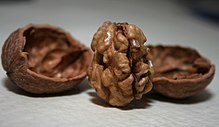Nutshell

A nutshell is the outer shell of a nut. Most nutshells are inedible and are removed before eating the nut meat inside. It covers and protects the kernel, which may be edible.
Usage[edit]
Most nutshells are useful to some extent, depending on the circumstances. Walnut shells can be used for cleaning and polishing, as a filler in dynamite, and as a paint thickening agent.[1][circular reference] Shells from pecans, almonds, Brazil nuts, acorns, and most other nuts are useful in composting.[2] Their high porosity makes them also ideal in the production of activated carbon by pyrolysis. Shells can also be used as loose-fill packing material, to protect fragile items in shipping.
Idiomatic usage[edit]
The expression "in a nutshell" (of a story, proof, etc.) means "in essence", metaphorically alluding to the fact that the essence of the nut - its edible part - is contained inside its shell. The expression further gave rise to the journalistic term nut graph, short for nutshell paragraph.
In Hamlet (Act 2, Scene 2) the title character exclaims: "O God, I could be bounded in a nutshell, and count myself a King of infinite space".
Pliny the Elder mentioned in the encyclopedic Naturalis historia a report by Cicero saying that a handwritten version of the Iliad by Homer would have fit in a nut[shell]: "in nuce inclusam Iliadem Homeri carmen in membrana scriptum tradit Cicero".[3]
References[edit]
- ^ "Walnuts as a filler in dynamite, thickening agent, and polisher". Wikipedia Juglans Article. Retrieved November 7, 2010.
- ^ "Composting Nut shells". GardenWeb. Retrieved November 7, 2010.
- ^ Naturalis historia, 7, 21, 85, Wikisource-Digitalisat
External links[edit]
- "How to Compost Peanut Shells". gardenguides.com.
- "Nutshell". Merriam-Webster.com Dictionary.
